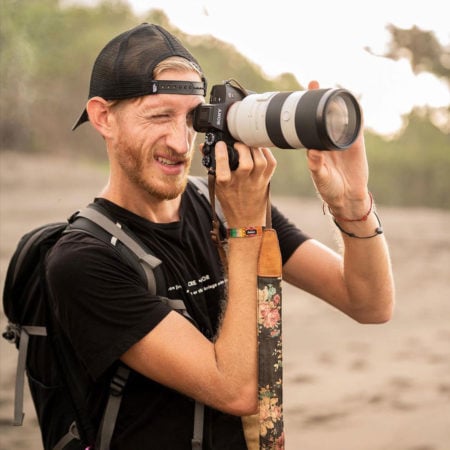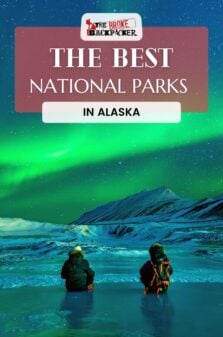Bigger is better. Alaska expands a whopping 3.3 million acres across moving glaciers, boreal forests, tundra biome, impressive mountains, and rugged coastlines. If wild is what you seek, wild is what you will find at some of the best national parks in Alaska.
Not only is this giant state bigger than the two next biggest states combined, but it also boasts the largest forest and glacier in the country, along with around three million lakes. The region is known for its wide-open spaces, natural beauty, and the incredible outdoor adventures that come with it.
While home to various fascinating Native cultures, Alaska is the third least populated state in the US and the least populated per square mile – by a mile! As you might expect, the state is a haven for explorers, adventurers, and photographers, with some of the most untouched landscapes in the world.
The land of the midnight sun houses eight official national parks along with a plethora of natural preserves, historical parks, public lands, and national monuments.
Enouch chat, let’s take a closer look at eleven of the state’s most exciting and diverse parks and protected areas, shall we?
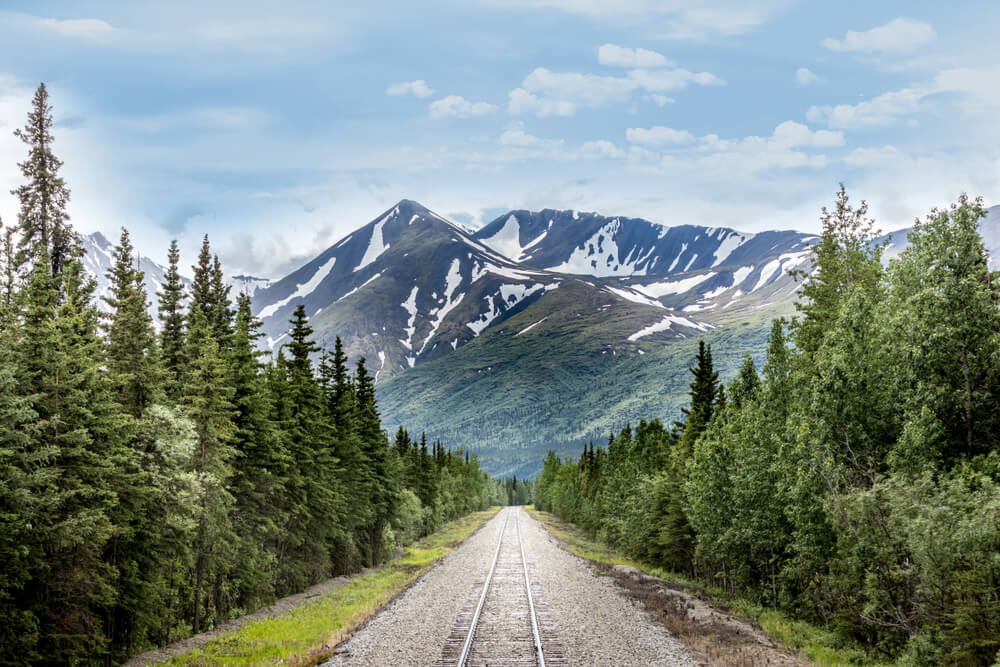
The Broke Backpacker is supported by you. Clicking through our links may earn us a small affiliate commission, and that's what allows us to keep producing free content 🙂 Learn more.
What are National Parks?
A national park is an area of land protected by the national government to preserve the natural environment, flora, and fauna that thrive within it. Some parks are designated to protect historical landmarks or to preserve natural phenomena. Others exist to create a space for public recreation.
Alaska is an outdoor lovers’ paradise, boasting wide open spaces stretching across millions of acres of land, including America’s most northern chain of mountains. With little civilization and development in the state compared with others, the remote region offers exceptionally clear skies and clean landscapes.
Home to massive expanses of land and some of the largest national parks in the world, seven of eight national parks in the state of Alaska rank in the top ten largest national parks in the USA. Regardless of size, these parks remain some of the least-visited in the country.
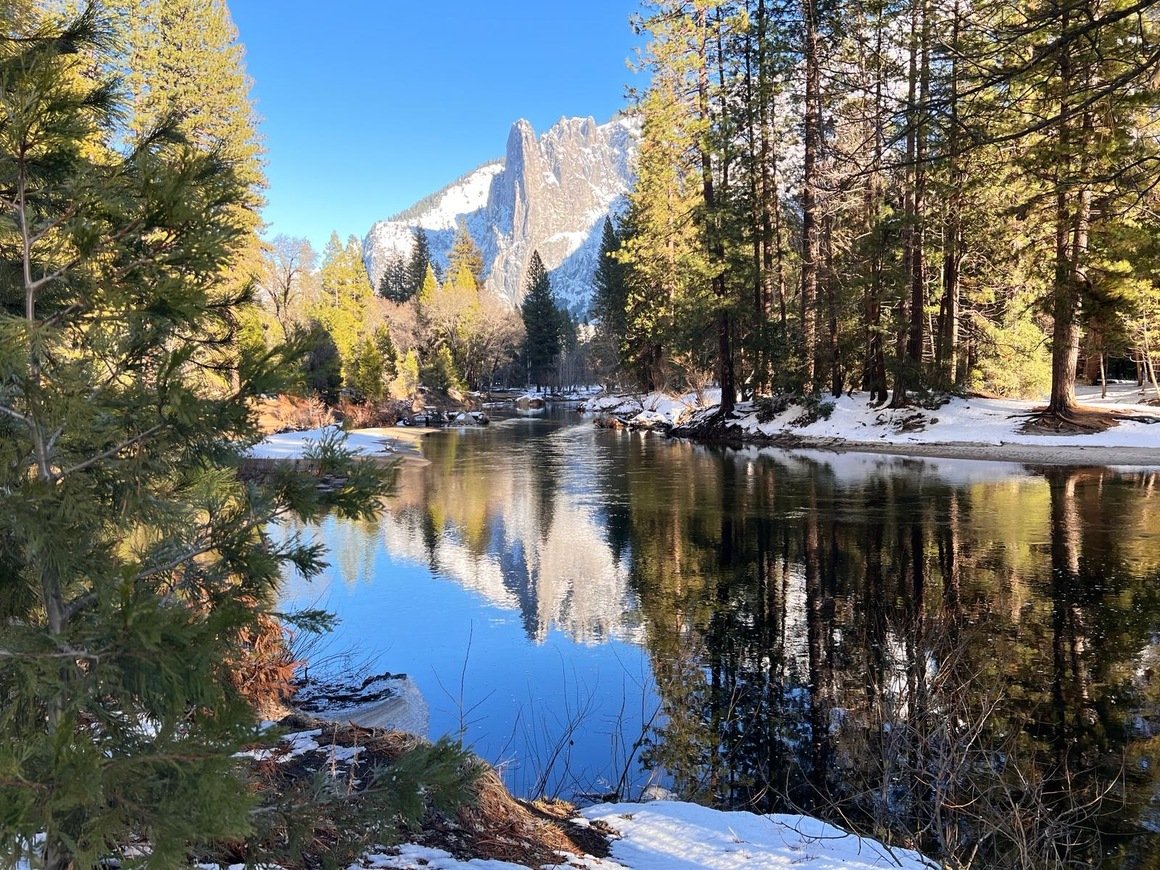
Alaska’s national parks offer different landscapes suited for various activities and adventures. For example, the Kenai Fjords National Park is made up of 50% glacier ice. In contrast, Mount Wrangell is one of three of the largest active volcanoes in the world, and the Great Kobuk Sand Dunes are North America’s largest Arctic sand dune field.
Whatever you’re into, you’ll find a national park in Alaska suitable for your activity. There’s a lot of variety here, to say the least!
National Parks in Alaska
Ready to make your way into the heart of America’s Arctic region? Let’s take a closer look at some of the largest, most diverse, and least-visited national parks in the American National Park System.
Denali National Park and Preserve

- Size: 9,375 sq mi
- Location: In central Alaska near Healy and Cantwell
- Entrance Fee: $15 per person and $30 per vehicle (valid for seven days)
Easily the most recognizable name on this list, Denali National Park and Preserve is also one of Alaska’s most visited parks, attracting visitors from across the globe. The namesake mountain is a bucket list for most mountaineers and advanced climbers who visit to tackle North America’s highest peak reaching 20,310 feet into the sky.
However, there are also many hiking opportunities for less advanced hikers looking for a spot of adventure. Take note that marked trails are limited, which means you might have to make your own path through the remote wilderness.
The massive wilderness is also home to various wildlife that roam through the park’s lush forests and treacherous alpine tundra. Since the trails are not maintained, running into sheep, bears, and wild moose is not uncommon.
Backpacking through the national park in Alaska is the best way to experience the natural surroundings, and the best time of year to do this is during the summer months. If you visit in winter, there are a few tours that depart from Healy that follow the otherworldly Northern Lights.
Denali is one of only three Alaska parks that can be accessed by road. It’s a four-and-a-half-hour bus drive from Anchorage.
In fact, on a clear day, you can even see Mount Denali in the distance from the town of Anchorage. However, the best place to view Mount Denali is from the Eielson Visitors Center.
Where to Stay near Denali National Park and Preserve:
This tiny Alaskan cabin in the woods by Healy offers a cozy loft space with space for four guests, only half an hour’s drive from the national park. If it’s booked or you’re looking for another option, check out my guide on where to stay in Denali.
Located on ancestral lands, the home is surrounded by nothing but nature and includes a full kitchen, children’s games and toys, and a balcony with outdoor furniture.
Gates of the Arctic National Park and Preserve

- Size: 13,125 sq mi
- Location: In central Alaska near Fairbanks
- Entrance Fee: Free
Located above the Arctic Circle, the Gates of the Arctic is an aptly named park that is also one of the most remote and wildest on the planet. It’s the second-biggest park in North America and one of the largest in the world.
The best part? It does not have one paved road or trail within it. It is totally wild.
One of the best things to do in this Alaskan national park is overnight treks and backpack camping. Be prepared to use your own navigation and survival skills in the park, which is surrounded by nothing but impressive mountains and lakes. The only way to survive in this vast wilderness is to live off the land like local indigenous tribes have done for centuries.
Another great way to explore the park is to float down one of the six rivers; John River, Noatak River, Alatna River, Koyukuk River, Kobuk River, or Tinyaguk River. With no roads in sight, the only way to get to these rivers is by air taxi. And of course, you’ll have to bring your own boat into the park (so make sure it is inflatable).
Other than by air taxi, some choose to tackle the rugged Dalton Highway route to access the park. However, this challenging hike should be attempted only by advanced mountaineers or at least those with a professional guide.
During the summer, the sun barely sets during the long days. The glowing Northern Lights dimly light the winter months too, which is just gorgeous.
Where to Stay near Gates of the Arctic National Park and Preserve:
Located in the nearest city to the park, this modern cabin offers cozy and convenient accommodation at the foothills of Chena Ridge in Fairbanks. The loft space is suitable for two guests and includes well-working Wi-Fi, a full kitchen, and black-out curtains for the summer months.
Glacier Bay National Park and Preserve

- Size: 5,156 sq mi
- Location: In southwest Alaska near the town of Gustavus
- Entrance Fee: $5 per person and $10 per vehicle (valid for seven days)
Glacier Bay National Park in Alaska is a sprawling winter wilderness that doubles as a UNESCO Biosphere Reserve and World Heritage Site. Located in a remote region of southwestern Alaska, the park can only be accessed by boat or small plane.
Many visitors arrive here by cruise ship during the summer months. The small town of Gustavus is the main gateway to the town, offering a few options for places to stay.
The most popular activity is to take a full-day boat tour of the bay, sailing around a few of the most impressive tidewater glaciers. One of them is Margerie Glacier, an active glacier that often changes form in a dramatic display of falling ice.
Within the park, you could also spot groups of sea lions, sea otters, and whales while sailing through the waters. With all the best views to be seen from the water, this park is one of the few where you won’t have to do much exercise to experience its most exquisite scenery.
Where to Stay near Glacier Bay National Park and Preserve:
In the heart of Gustavus, this simple cabin offers all the modern conveniences you could dream of.
Ideal for four guests, the cabin is a short walk to the river, beach, and multiple hiking trails and a short distance from the Glacier Bay National Park. It has a fully equipped kitchen, including washer and dryer facilities and cooking and cleaning basics.

We’ve tested countless backpacks over the years, but there’s one that has always been the best and remains the best buy for adventurers: the broke backpacker-approved Osprey Aether and Ariel series.
Want more deetz on why these packs are so damn perfect? Then read our comprehensive review for the inside scoop!
View on Osprey View on REIKatmai National Park and Preserve

- Size: 5,625 sq mi
- Location: In southwest Alaska near King Salmon
- Entrance Fee: Free
Katmai National Park and Preserve was founded in 1918 to protect the flourishing salmon populations and the brown bears that feed on the fish in its wild rivers. You’ve always wanted to see a bear in its natural habitat, haven’t you?
Well, this park is one of the best places to spot these unique mammals. Over 2,000 brown bears are living in this national park in Alaska.
The region is also a volcanic landscape with 18 separate volcanoes, seven of which are active. With bears hunting salmon against volcanic mountain backdrops, it’s no surprise the park is a hotspot for wildlife lovers and photographers.
Brooks Camp and Brooks Falls offer some great opportunities to view bears, with various viewing platforms suspended along the river offering perfect views. The camp is open from June through September, with limited services offered in the winter months.
Around 290 miles from Anchorage, with no designated roads in the park, the only way to access the area is by plane. Most catch a flight from Anchorage to King Salmon and then travel by seaplane or boat to the national park.
You’ll find the most impressive volcanic landscapes around The Valley of Ten Thousand Smokes. Here, visitors can camp and enjoy treks through the untouched wilderness.
Where to Stay near Katmai National Park and Preserve:
There is minimal accommodation around Katmai National Park, and this spacious home in King Salmon is just ten miles from the park and fifteen minutes from Naknek.
The two-bedroom home has a sunroom and terrace and offers a sauna, unlimited internet, a fully equipped kitchen, and a BBQ and outdoor dining area.
Kobuk Valley National Park

- Size: 2,656 sq mi
- Location: In northwest Alaska near Kotzebue
- Entrance Fee: Free
Perhaps the most unique national park in Alaska, Kobuk Valley offers scenery nonexistent anywhere else in this northern tundra region. Located within the Arctic Circle, millions of years’ worth of grinding and moving glaciers have shaped what is now known as the Great Kobuk Sand Dunes.
Like most parks in the state, you’ll have to travel far and wide (and pay your way) into this unique ecosystem, which has no trails, amenities, or safety services. The Arctic desert landscape can be accessed on foot, following unmarked trails through magnificent forests and bubbling rivers.
The dunes are popular for hiking and camping. There are enough routes and trails (although not consistently defined or maintained) to keep you busy for days on end.
Another one of the best things to do here is to boat or kayak down the Kobuk River from Ambler to Kiana, venturing through the remote region without laying eyes on another human. The valley is also famous for its impressive wildlife viewing. Huge herds of caribou roam the region throughout their annual migration.
Where to Stay near Kobuk Valley National Park:
Kotzebue is pretty far from the park but is one of the few towns where you can get a direct air taxi into Kobuk Valley National Park.
This simple apartment in Kotzebue is spacious and comfortable. It features a double bed, kitchenette, and private bathroom near the National Park Service Heritage Center and Museum.
Lake Clark National Park and Preserve
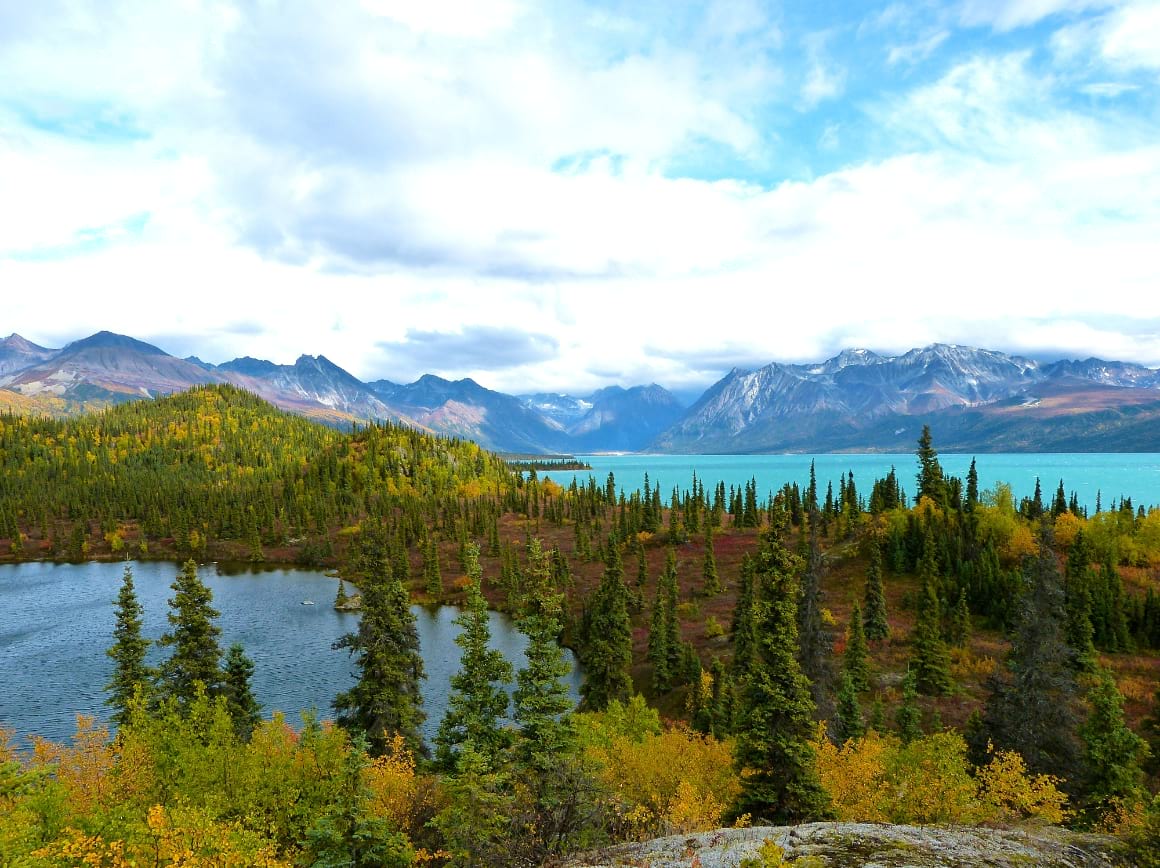
- Size: 6,250 sq mi
- Location: In southwest Alaska near Port Alsworth
- Entrance Fee: Free
Another park that can’t be accessed by roads is Lake Clark National Park and Preserve. Visiting here is only possible by small plane or seaplane. The lake is a playground for outdoor adventurers, with rafting, camping, hiking, and wildlife viewing opportunities.
Once in the park, some basic and luxurious homes and cabins are available to rent. However, many choose to camp in the great wilderness. Port Alsworth is a small town that offers the perfect base for those exploring Lake Clark.
Not only is the park home to the state’s sixth largest lake but also an active volcano and one dormant one. Between these mountainous alpine landscapes, plenty of water and land adventures can be experienced in the park.
Brown bear viewing is popular in the park. They can be seen on day-long hikes along the Tanaluan Trails, which lead to the Tanalian Falls and Kontrashibuna Lake Beaver Pond.
The best time to visit this national park in Alaska is during spring. This is when hungry and sleepy bears emerge from hibernation and come together to indulge in a salmon feast in Chinitna Bay, Crescent Lake, and Silver Salmon Creek.
Where to Stay near Lake Clark National Park and Preserve:
For a luxurious vacation on the pristine lakefront, this lodge cabin is designed for those looking to experience the true tranquility and nature of the Alaskan bush. The lodge offers meal and excursion opportunities as well as all the amenities of a self-catering vacation rental.
Enjoy your morning coffee on the terrace overlooking the water and share stories of your adventures around the campfire in the evening.

Get 15% OFF when you book through our link — and support the site you love so dearly 😉
Booking.com is quickly becoming our go-to for accommodation. From cheap hostels to stylish homestays and nice hotels, they’ve got it all!
View on Booking.comWrangell-St. Elias National Park and Preserve
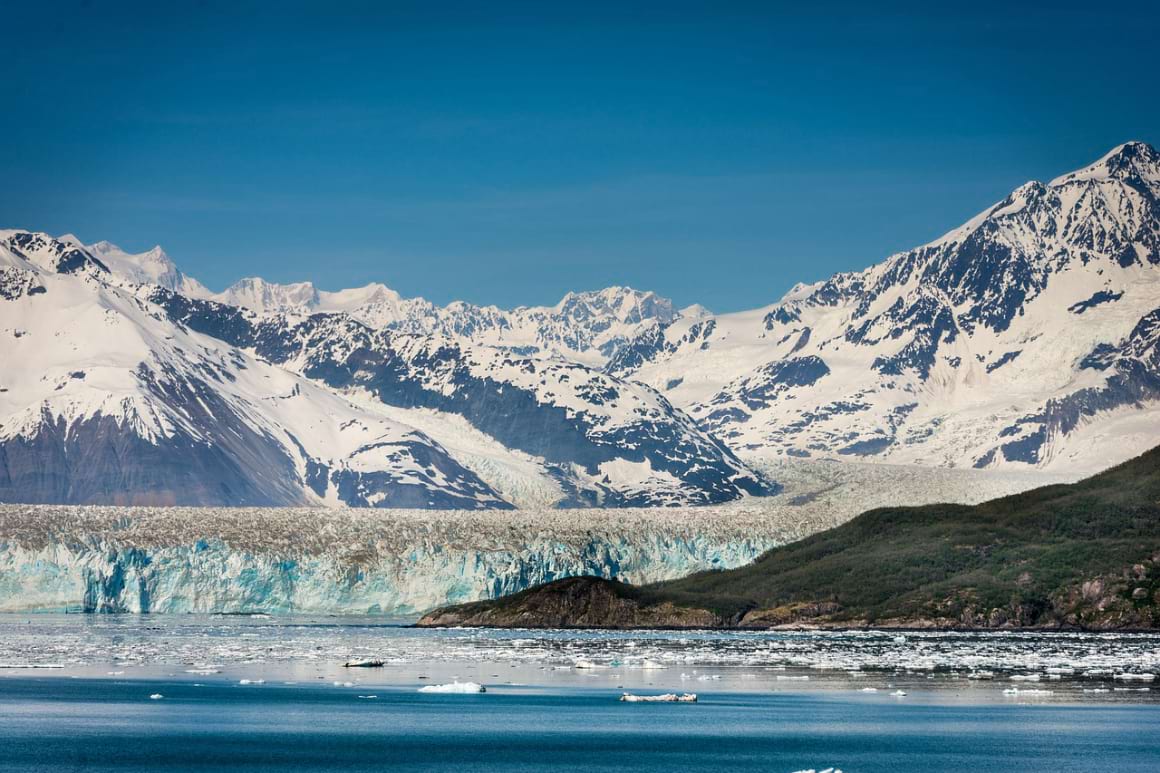
- Size: 20,625
- Location: Stretches across southcentral and southeast Alaska around McCarthy and Kennecott
- Entrance Fee: $15 per person and $30 per vehicle (valid for seven days)
Alaska is home to some pretty massive parks, but none can even come close to competing with the sheer magnitude of Wrangell-St. Elias National Park and Preserve. This park includes nine of sixteen of the country’s tallest mountain peaks, as well as glacial landscapes, boreal forests, and world heritage sites.
There are two access roads and many hiking trails that make it (relatively) easy to explore the wilderness compared with other parks on this list. Even though the park is one of three that is accessible by road, it is still visited by a few visitors each year.
You’ll have to complete a seven-and-a-half-hour road trip from Anchorage through three different mountain ranges to reach the park. A non-tarred road runs through the park connecting McCarthy to Chitina and Kennicott, a deserted ghost town worth checking out.
With impressive glaciers soaring into the sky from the alpine mountain terrain, ice-climbing and mountaineering are two of the most popular activities in this Alaskan national park. Other activities include boating and fishing in one of the many lakes, while hiking and camping are also highly recommended.
Where to Stay near Wrangell-St. Ellias National Park and Preserve:
Surrounded by nothing but meadows and mountains in McCarthy, this cozy cabin is the perfect off-the-beaten-track destination inside the country’s largest national park.
A truly wild experience, the cabin has no electricity or indoor plumbing, with a separate shower house and a wood-burning stove to keep the home warm.
Kenai Fjords National Park
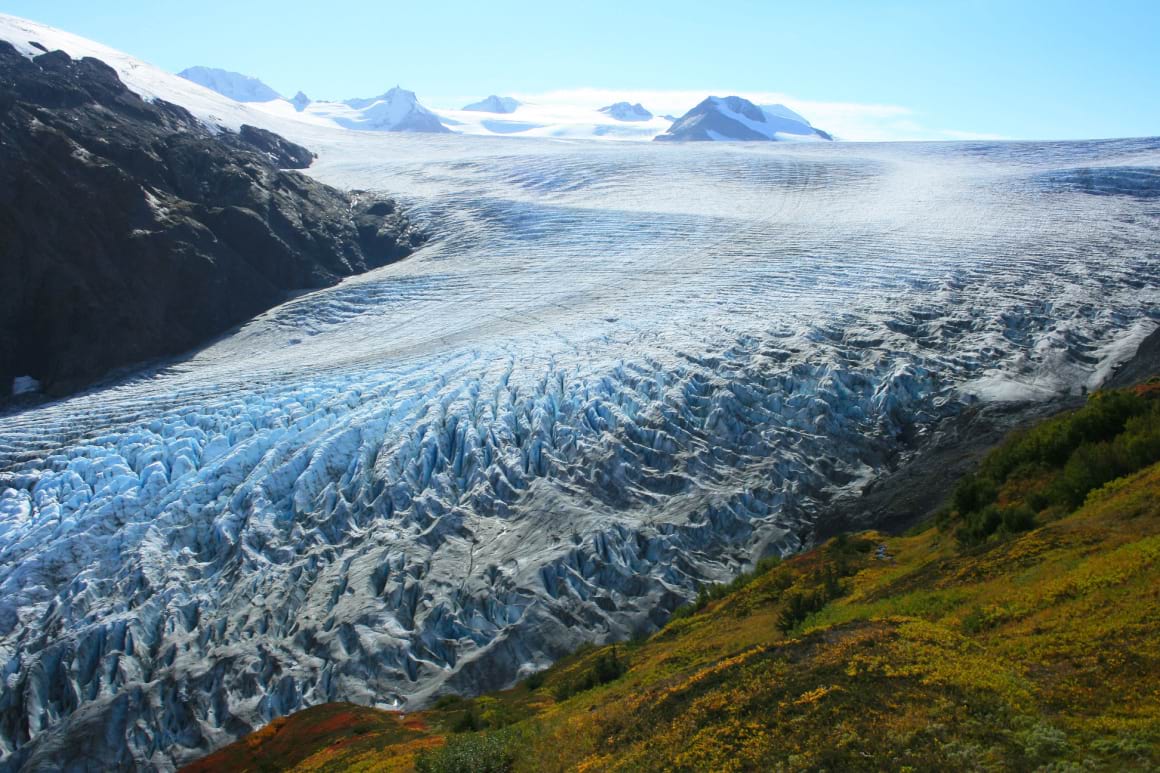
- Size: 1,046 sq mi
- Location: In southcentral Alaska near Seward
- Entrance Fee: $15 per person and $30 per vehicle (valid for seven days)
One of the state’s smaller parks is Kenai Fjords National Park in southern Alaska. Despite its beauty, it’s also one of the least visited. This is not for any reason other than that it is difficult to access, and the park is a paradise for anyone passionate about untouched glacial scenery.
Conveniently, the park’s most famous attraction is also the only location that can be accessed by car. Exit Glacier is a seemingly neverending glacier that looks more like an ocean wedged between the boreal landscape and the impressive mountains.
Around the glacier, there are plenty of camping opportunities and hiking trails, one of which allows you to hike over the Harding Ice Field. That said, most visitors arrive by boat to experience the picture-perfect fjords from a different perspective.
Not only do these fjords offer spectacular views of the wilderness, but they are also home to incredible ocean wildlife, including orcas, seals, puffins, and humpback whales. Kayaking, boating, and hiking are all popular activities here. Those with cash to spare can even charter a helicopter to admire the glacier and fjords from a bird’s eye view.
Where to Stay near Kenai Fjords National Park:
Built in the 1930s, this traditional Alaskan log cabin offers cozy and comfortable accommodation for two in Seward. Perfect for the minimalistic traveler, the cabin includes only the necessities, including a basic kitchenette, a queen-sized bed, and a porch.
Other Parks in Alaska
Are you not inspired yet!? Don’t worry, pal. Here are a few extra parks in Alaska that may just be right up your street.
Sitka National Historical Park

- Size: 113 acres
- Location: In southeast Alaska near Sitka
- Entrance Fee: Free
Sitka National Historical Park is Alaska’s oldest, yet smallest park. Not even one square mile in size, the park packs a real punch when it comes to outdoor adventure and fascinating history.
Sitka was designated as a preserved area in 1910 to remember the Battle of 1804 between the Tlingits and the Russians. Visitors can join ranger-guided walks and treks focused on the battle and its historical significance.
Unlike most of Alaska’s national parks, this historical park is easy to access and is popular with families, backpackers, and even solo travelers.
Some of the park’s main attractions are the twenty totem poles set amongst a backdrop of coastal rainforest. Generally conveying the ancestry of a particular clan or tribe, some of these poles were used to support traditional houses or simply to commemorate a significant person or event.
The Totem Trail is a mile-long route that winds through spruce trees and a footbridge over the Indian River, passing a few replica Tlingit and Haida totem poles along the way.
The Russian Bishops House is another major attraction in the park, showcasing the oldest intact Russian building. Built in 1843 out of natural spruce trees, the log cabin is one of only a few examples of Russian colonial architecture in America.
Whatever your reasons for visiting, the Visitor Center provides maps, a small exhibit, and knowledgeable guides. These guides are great; they’ll help make your park visit as enjoyable as possible.
Where to Stay near Sitka National Historical Park:
The Dreaming Bear Suites offer a taste of cabin life in the town of Sitka, which is the nearest town to the national historical park.
Hidden in a residential garden, the apartment has an open-concept format with a living area, kitchen, and private bedroom. There are cabin-inspired interiors like wooden ceilings and floors, and warm lighting.

Here at The Broke Backpacker, we love freedom! And there’s no freedom as sweet (and CHEAP) as camping around the world.
We’ve been camping on our adventures for over 10 years, so take it from us: the MSR HUBBA HUBBA is the best damn tent for adventuring…
View on REI Read Our ReviewNoatak National Preserve
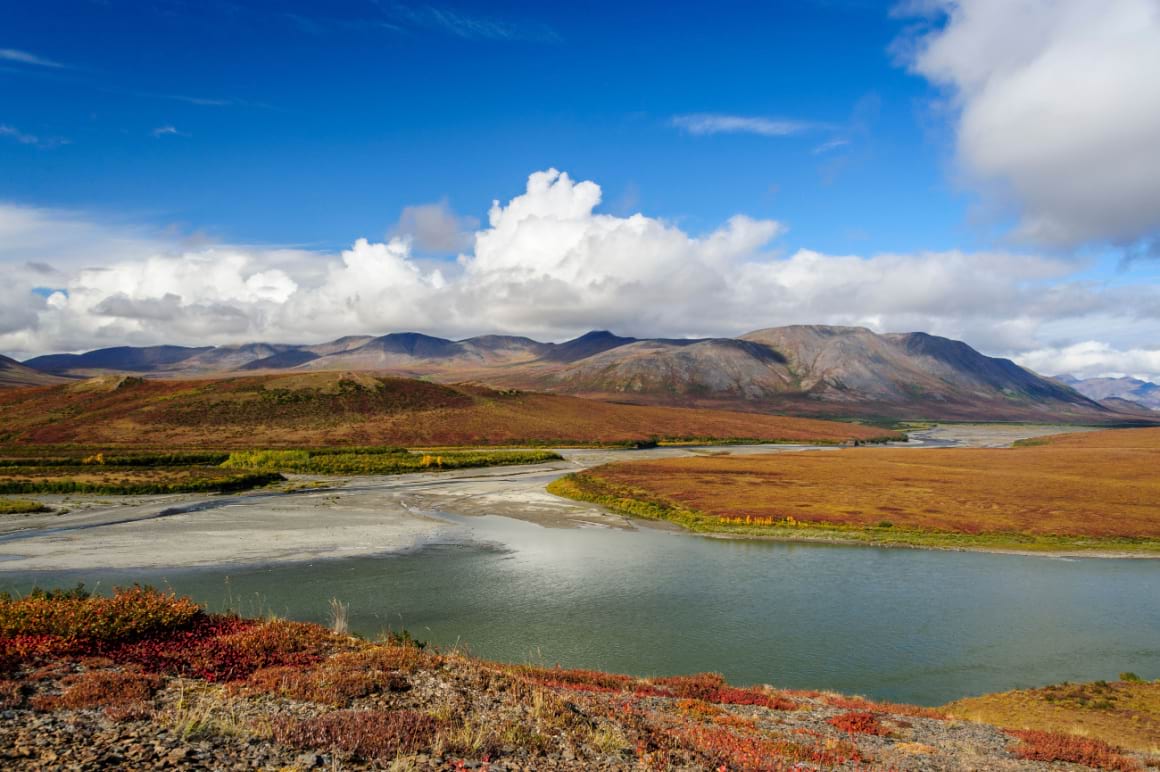
- Size: 10,264 sq mi
- Location: In northwest Alaska near Kotzebue
- Entrance Fee: Free
Nestled between the Baird and De Long Mountains, Noatak National Preserve was founded to protect one of North America’s most extensive mountain-surrounded river basins. The park marks the spot where the Noatak River terrain transitions from forest to tundra.
The remote park is difficult to reach and only accessible via boat or small plane. However, if you are adventurous enough to make the trip, you will be rewarded with exceptional views of the Brooks Mountain Range and river basin.
Adventurous travelers visit the park to hike into the backcountry tundra, also home to massive herds of wild Arctic caribou. Another incredible thing to do in this Alaskan national park is to float along the river and experience class two rapids.
The river flows from glacial melt carving out canyons through the parks’ coniferous forests and tundra biomes. A dream come true for bird watchers, this river region is home to over 150 songbird species living in harmony with brown bears, wolves, lynx, and moose.
Where to Stay near Noatak National Preserve:
This cozy suite in uptown Kotzebue is one of the few places to stay in this town. The room features a living room and kitchen with washer and dryer facilities and a private bedroom with a comfortable queen-sized bed.
Bering Land Bridge National Preserve
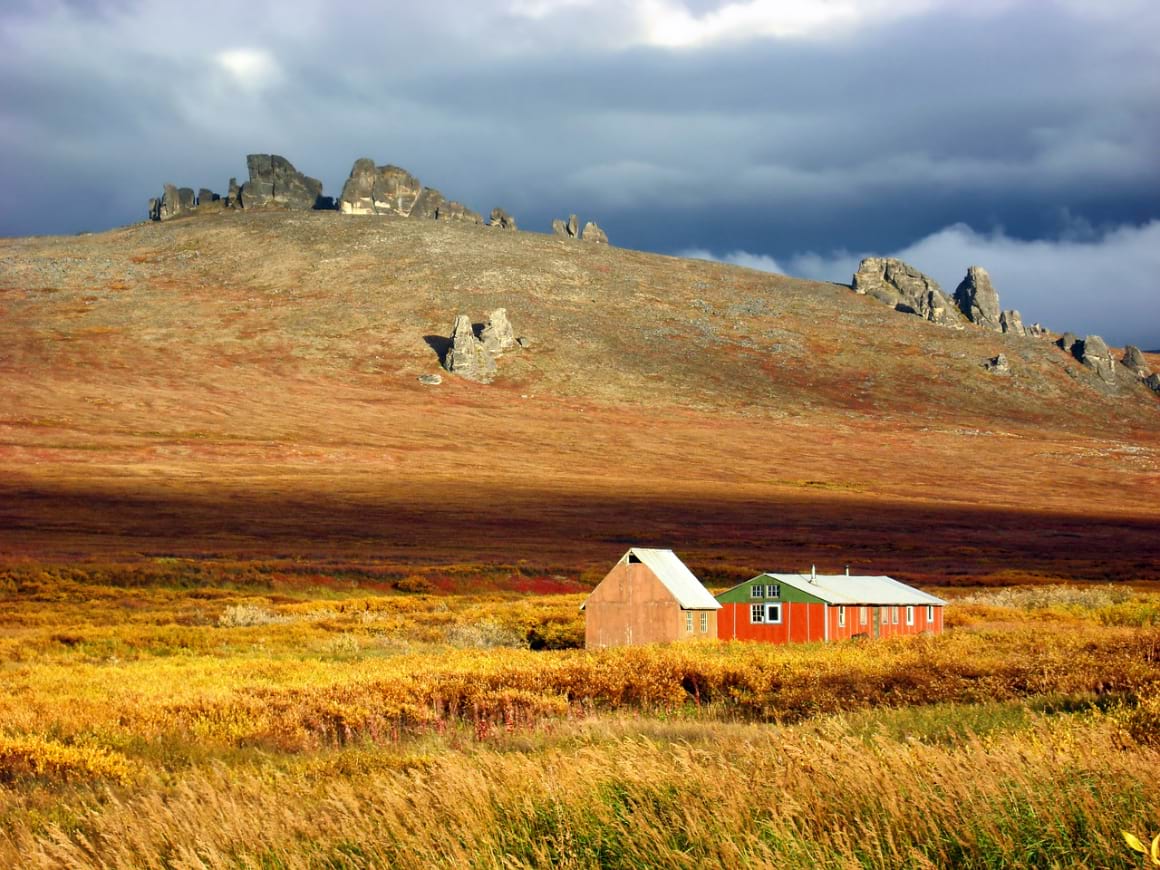
- Size: 4,219 sq mi
- Location: In northwest Alaska near Nome
- Entrance Fee: Free
The Bering Land National Bridge preserves what remains of the land bridge that used to connect Asia with North America over 13 thousand years ago. It’s easily one of the most remote protected lands in the world.
Thousands of years ago, the bridge allowed people, birds, and animals to migrate across the continents. Today, most of this land bridge is submerged by the Chukchi and Bering Seas. The region represents the continental crossroads that allowed humankind to explore and expand into the Western Hemisphere.
It covers parts of Alaska’s remote polar tundra, boasting a landscape of contrasts, including volcanoes, barrier islands, and picturesque lagoons. One of the most incredible ways to experience this expansive area and the dramatic movement of the earth over millennia is from a bird’s eye view flight.
Although no designated camping spots exist in the preserve, camping, and hiking are permitted. Berry picking is another great thing to do in this national park in Alaska, where around fifty wild berry species flourish during the fall months.
Where to Stay near Bering Land Bridge National Preserve:
Set in the heart of Nome, this cozy apartment includes a spacious living, dining, and kitchen area, as well as two private bedrooms and an outdoor deck. It’s a five-minute stroll to restaurants and businesses in the town and is decorated with inviting modern interiors.
Get Insured on Your Alaskan Adventures
Look, national parks are great… BUT… you’re gonna want to prepare for unpredictable or dangerous scenarios. How? With some reliable travel insurance for the USA, that’s how.
ALWAYS sort out your backpacker insurance before your trip. There’s plenty to choose from in that department, but a good place to start is Safety Wing.
They offer month-to-month payments, no lock-in contracts, and require absolutely no itineraries: that’s the exact kind of insurance long-term travellers and digital nomads need.
SafetyWing is cheap, easy, and admin-free: just sign up lickety-split so you can get back to it!
Click the button below to learn more about SafetyWing’s setup or read our insider review for the full tasty scoop.
Final Thoughts on Alaska’s National Parks
If Alaska is known for anything, it would be its incredible natural landscape and massive outdoor spaces. The entire state is a dream come true for anyone who appreciates the great outdoors. It’s home to some of the most diverse terrains, least-visited and most remote destinations, and the biggest national parks in the world.
In fact, it is within Alaska’s national parks where you will find some of the world’s most magnificent natural phenomena. Here you can discover one of the world’s largest active volcanoes, the most northern mountain ranges in the world and North America’s highest mountain peak.
The best part though? Witnessing parks so remote you have to access them via private plane or flight taxis.
As the country’s least visited national park, the Gates of the Arctic National Park and Preserve is an incredible place to visit and my personal favorite. With little to no civilization, trails, roads, or visitor centers in this park, it is truly wild. It offers an experience unique from other national parks of showing off the remote wilderness with not another soul in sight.
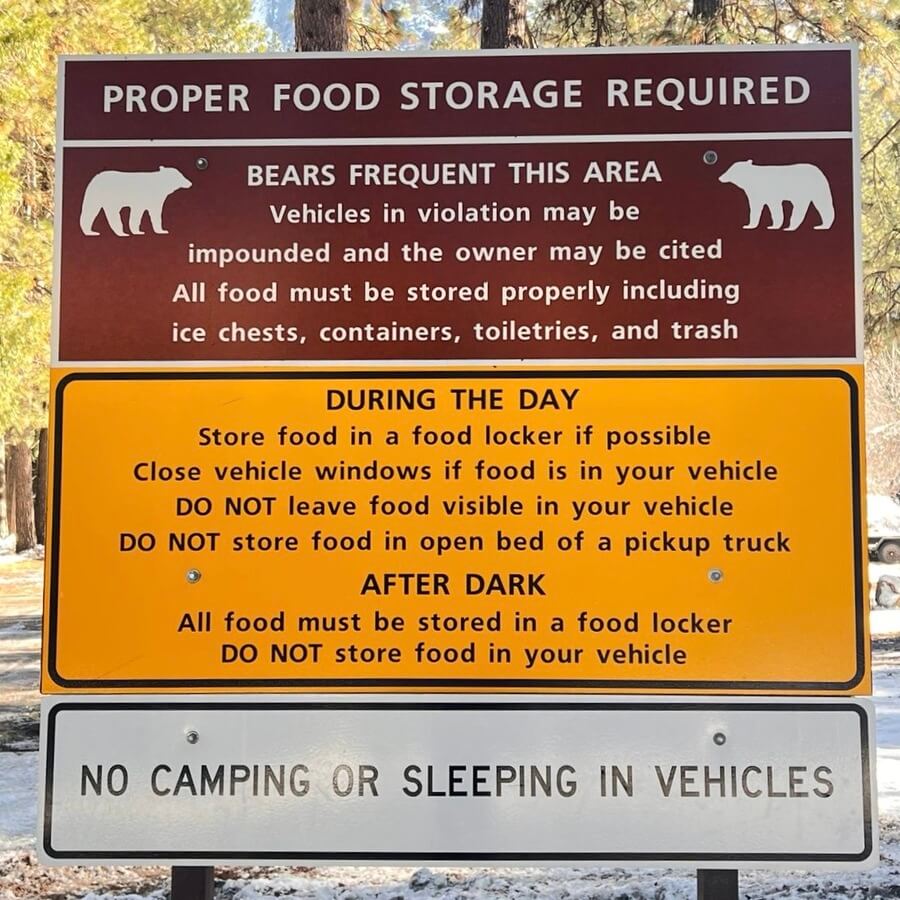
Photo: @joemiddlehurst
- Check out the best hostels in Anchorage to kickstart your adventure.
- Prepare yourself for wilderness by learning how to stay safe in USA.
- Switch up the vibe from being in the wild to being wild yourself at one of USA’s best festivals.
- If you are stuck in Anchorage, don’t worry – there are plenty of things to do.
- And bring your travel camera to capture the breathtaking views Alaska has to offer!
- Let’s get you ready for your next adventure with our California backpacking guide.
Buy Us a Coffee!
A couple of you lovely readers suggested we set up a tip jar for direct support as an alternative to booking through our links. So we created one!
You can now buy The Broke Backpacker a coffee. If you like and use our content to plan your trips, it’s a much appreciated way to show appreciation 🙂




